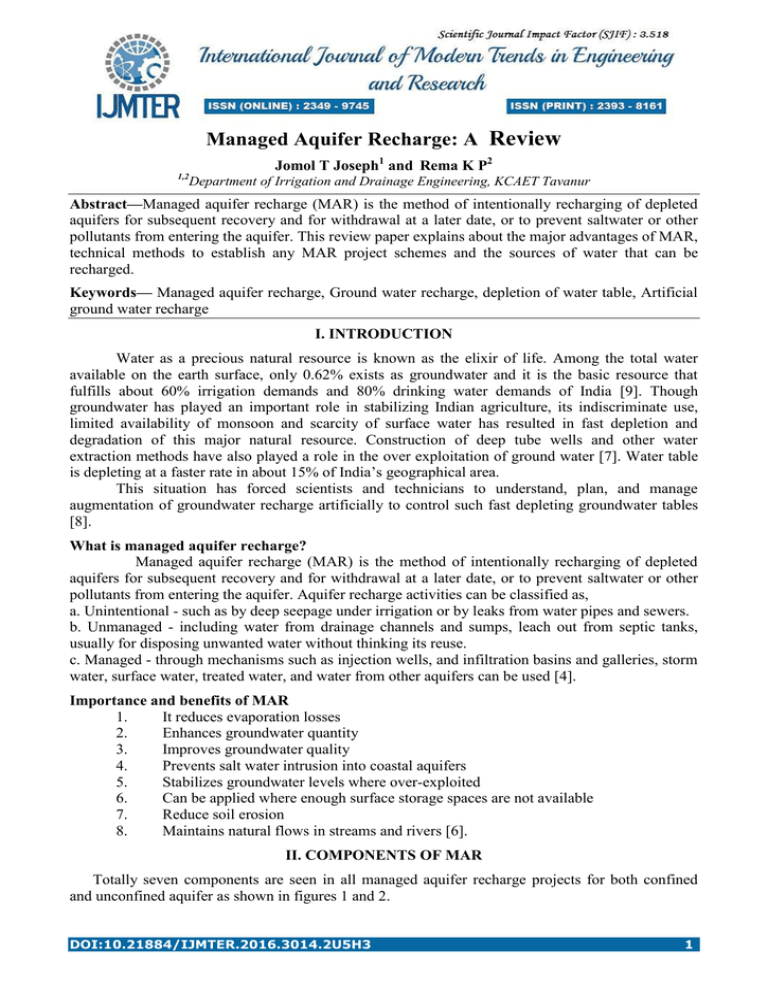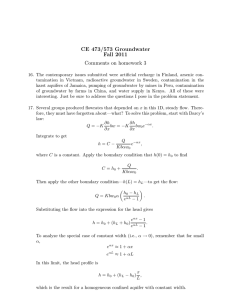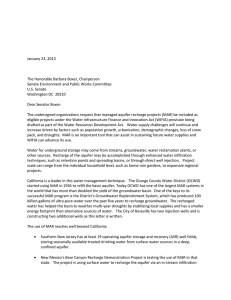
Managed Aquifer Recharge: A Review
Jomol T Joseph1 and Rema K P2
1,2
Department of Irrigation and Drainage Engineering, KCAET Tavanur
Abstract—Managed aquifer recharge (MAR) is the method of intentionally recharging of depleted
aquifers for subsequent recovery and for withdrawal at a later date, or to prevent saltwater or other
pollutants from entering the aquifer. This review paper explains about the major advantages of MAR,
technical methods to establish any MAR project schemes and the sources of water that can be
recharged.
Keywords— Managed aquifer recharge, Ground water recharge, depletion of water table, Artificial
ground water recharge
I. INTRODUCTION
Water as a precious natural resource is known as the elixir of life. Among the total water
available on the earth surface, only 0.62% exists as groundwater and it is the basic resource that
fulfills about 60% irrigation demands and 80% drinking water demands of India [9]. Though
groundwater has played an important role in stabilizing Indian agriculture, its indiscriminate use,
limited availability of monsoon and scarcity of surface water has resulted in fast depletion and
degradation of this major natural resource. Construction of deep tube wells and other water
extraction methods have also played a role in the over exploitation of ground water [7]. Water table
is depleting at a faster rate in about 15% of India’s geographical area.
This situation has forced scientists and technicians to understand, plan, and manage
augmentation of groundwater recharge artificially to control such fast depleting groundwater tables
[8].
What is managed aquifer recharge?
Managed aquifer recharge (MAR) is the method of intentionally recharging of depleted
aquifers for subsequent recovery and for withdrawal at a later date, or to prevent saltwater or other
pollutants from entering the aquifer. Aquifer recharge activities can be classified as,
a. Unintentional - such as by deep seepage under irrigation or by leaks from water pipes and sewers.
b. Unmanaged - including water from drainage channels and sumps, leach out from septic tanks,
usually for disposing unwanted water without thinking its reuse.
c. Managed - through mechanisms such as injection wells, and infiltration basins and galleries, storm
water, surface water, treated water, and water from other aquifers can be used [4].
Importance and benefits of MAR
1.
It reduces evaporation losses
2.
Enhances groundwater quantity
3.
Improves groundwater quality
4.
Prevents salt water intrusion into coastal aquifers
5.
Stabilizes groundwater levels where over-exploited
6.
Can be applied where enough surface storage spaces are not available
7.
Reduce soil erosion
8.
Maintains natural flows in streams and rivers [6].
II. COMPONENTS OF MAR
Totally seven components are seen in all managed aquifer recharge projects for both confined
and unconfined aquifer as shown in figures 1 and 2.
DOI:10.21884/IJMTER.2016.3014.2U5H3
1
International Journal of Modern Trends in Engineering and Research (IJMTER)
Volume 03, Issue 09, [September– 2016] ISSN (Online):2349–9745; ISSN (Print):2393-8161
1.1 Confined Aquifer
Depending on the type of aquifer available for recharge, MAR projects will vary its nature. In
confined aquifers, water is allowed to inject through a well.
Figure 1: Components of MAR in Confined aquifer [4]
1.2 Unconfined Aquifer
Unconfined aquifers allow water to infiltrate through permeable soils, where recharge can be
augmented by basins and galleries.
Figure 2: Components of MAR in Unconfined aquifer [4]
III. METHODS OF MAR
A number of methods can be used to recharge water intentionally into aquifers with respect to
different local conditions.
3.1 Direct surface methods
3.1.1 Infiltration ponds and basins: Allowing water to infiltrate to the aquifer by diverting surface
flows. Area available for basins and infiltration rate controls the amount of water to be recharged [6].
3.1.2 Soil Aquifer Treatment (SAT): Treated sewage effluent is allowed to infiltrate through
infiltration ponds in order to remove pathogens and nutrients. In this method both soil and aquifer
considered as natural filters [5].
3.1.3 Recharge releases: Dams on ephemeral streams are used to retain flood water in the upstream,
and slowly releases water into the streambed and then to infiltrate into underlying aquifers, thereby
augmenting recharge [4].
3.1.4 Ditches and furrows: For obtaining maximum water contact area for recharge water, ditches
and furrows should arrange closely in areas having irregular topography [1].
@IJMTER-2016, All rights Reserved
2
International Journal of Modern Trends in Engineering and Research (IJMTER)
Volume 03, Issue 09, [September– 2016] ISSN (Online):2349–9745; ISSN (Print):2393-8161
3.2 Direct subsurface methods
3.2.1 Recharge Wells: Abandoned bore wells or dug wells in alluvial soil or hard rock areas can be
used as recharge wells by gravity flow, when enough source water is available. Diameter of the wells
may ranges from 2 to 5m and depth will be up to 20m. Recharge water may be diverted through a
filter media to avoid clogging of the well and guided through a pipe to the bottom of the well to
eliminate the scoring of the well bottom [3].
a.
Aquifer Storage and Recovery (ASR): This is the method of injecting water into a well for
storage and recovery of the water from the same well. It is useful in aquifers with saline water, where
storage is the primary consideration and water treatment is a lesser consideration.
b.
Aquifer storage, transfer and recovery (ASTR): This is the method of injecting water into a
well for storage, and recovery from a another well. This is used to provide additional water treatment
in the aquifer by giving extra residence time in the aquifer beyond that of a single well [4].
3.2.2 Injection wells: Injection wells are similar to recharge wells used for augmenting recharge of
confined aquifer by pumping in water under pressure. Usually bore holes of 20 cm diameter should
be inserted 2 to 3 m below water table. Proper filtration mechanism should be provided at the top.
Effectiveness of injection wells depend on,
•
Pumping rate
•
Permeability of aquifer
•
Natural ground water gradient
•
Type of well
3.2.3 Recharge shafts: When a shallow aquifer is located below impermeable surface, this method
can be adopted. Shaft should be 0.5 to 3m in diameter and depth should be within 10 to 15 m. The
shaft should be drilled up to an impermeable stratum. For filtration of recharge water, gravel, pebble,
coarse sand should be packed within the shaft. Up to 1 to 2 m in the top, brick work can be carried
out for the stability of the shaft.
3.2.4 Recharge pits: This method can be adopted where permeable strata is present at shallow depth.
Recharge pit of any cross-section is excavated generally 1- 2m wide and 2- 3m deep. The pit is filled
with boulders, gravel and sand for filtration of source water [2].
3.2.5 Recharge trenches: In this, trenches of 0.5-1.0 m width, 1-1.5 m depth and 10- 20 m length
can be constructed. Trenches should be filled with gravel and sand for cleaning of recharge water.
This method can be used to recharge a shallow permeable aquifer.
3.3 Indirect methods
3.3.1 Aquifer modifications: This technique modifies the aquifer parameters to increase the
capacity to store and transmit water. With such alterations, the aquifer becomes capable of achieving
more natural as well as artificial recharge. Such techniques include,
a.
Bore blasting
b.
Hydro-fracturing
3.3.2 Induced recharge: It is also an indirect method of artificial recharge by pumping water from
aquifer, which is hydraulically connected with any surface water sources to induce recharge to the
ground water reservoir [10].
IV. SOURCES OF WATER CAN BE RECHARGED
Surface water, storm water and reclaimed water are the abundant sources of recharge. In
order to assess the effectiveness of managed aquifer recharge in water quality aspect it is important
to understand the baseline water quality, the impacts of anthropogenic activities and the geochemical
processes involved like groundwater abstraction, irrigation, land use, agriculture and forestry,
urbanization, liquid and solid waste disposal, salt water intrusion, chemical composition of the rocks
etc.
@IJMTER-2016, All rights Reserved
3
International Journal of Modern Trends in Engineering and Research (IJMTER)
Volume 03, Issue 09, [September– 2016] ISSN (Online):2349–9745; ISSN (Print):2393-8161
4.1 Surface water: Surface water is the major source of recharge, if it not polluted or free from all
suspended matters it can be directly diverted to the recharge structure. But polluted water from rivers
and lakes should go through certain pretreatment process for purification prior to recharge.
4.2 Storm water runoff: Due to the variability in quality aspects of storm water runoff, greater care
should be taken before executing the recharge process. Good quality water from rooftops can be
directly diverted to dug wells or bore wells. If the contaminated water from industrial runoff, animal
wastes, decaying vegetation, and chemicals applied to agricultural lands, septic tank seepage and
litter etc. are used for direct recharge, in order to accommodate the soil infiltration effect, treatments
like sand filtration is prescribed before recharge.
4.3 Potable water: In arid regions, especially in gulf countries, fresh water coming out of
desalination plants is used to recharge aquifer. Due to the high quality of this treated water, chemical
and physical properties of aquifer are not altered.
V. CONCLUSION
With respect to the population growth and over-exploitation of water resources, there is a
need for adopting more sustainable groundwater management strategies. In this paper, detailed
description on a promising groundwater management technique called MAR has been done. Even
though the literature on MAR in India is abundant, there is an absence of a structured approach and
implementation of this technique. A planned approach along with people’s participation is essential
for the implementation and management for the success of every MAR projects. We have to harvest
every droplets of water every possible places.
REFERENCES
[1] Bhattacharya, A.K, “Artificial groundwater recharge with a special reference to India”, Int. J. Res. Rev. Appl. Sci.
4(2):214-221, 2010.
[2] CAMTECH [Centre for Advanced Maintenance Technology], “ Water Harvesting. Government of India - Ministry
of Railways”, 22p, 2010.
[3] CGWB [Central Ground Water Board, Ministry of Water Resources], “Guide on Artificial Recharge to Ground
Water”, Central Ground Water Board, Ministry of Water Resources, 17p, 2000.
[4] Dillon, P., Pavelic, P., Page, D., Beringen, H., and Ward, J, ”Managed aquifer recharge: An Introduction”,
Waterlines Report Series No. 13, Australia, 2009.
[5] Drewes, J. E., Quanrud, D., Amy, G., and Westerhoff, P, “Character of Organic Matter in Soil-Aquifer Treatment
Systems”, J. Environ. Eng. 11: 1447-1458, 2006.
[6] Gale, I.N., and Dillon, P, “Strategies for Managed Aquifer Recharge (MAR) in semi-arid areas”, UNESCO’s
International Hydrological Programme, de Fontenoy, Paris, 33p, 2005.
[7] Patel, R.J., Rank, H.D., Ajudiya, B.H., and Dhanani, N.V, “An Assessment of Groundwater Recharge Potential
through Tube Well”, Int. J. Eng. Res. Technol. 3(10):155-160,2014.
[8] Samadder, R.K., Kumar, S., and Gupta, R.P, “Palaeochannels and their potential for artificial groundwater recharge
in the western Ganga plains”. J. Hydrol. 400: 154–164, 2012.
[9] Satyendra, K., Kamra, S.K., Yadav, R.K., and Bhaskar, N, “Effectiveness of Horizontal Filter for Artificial Ground
Water Recharge Structure”, j. Agric. Eng. 51 (3): 24-33, 2014.
[10] Yadav, A., Abhijit, S., Priyanka, M., and Jain, D.A, “ A Review on Artificial Ground water Recharge”, Int. J.
Pharm. Bio. Sci. 3(3): 304-311, 2012.
@IJMTER-2016, All rights Reserved
4





